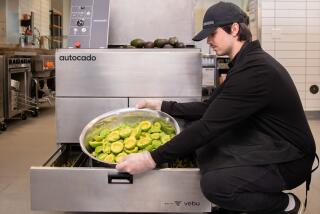Hospitals Upgrading Food Service Operations
- Share via
DANBURY, Conn. — Roscoe and Rosie each weigh 600 pounds and they’re less than 5 feet tall, but that doesn’t stop them from being Danbury Hospital’s most productive workers.
For 12 hours each day, seven days a week, they haul meal trays from the basement kitchen to the patient floors. They cost the hospital just $6 an hour each with no overtime, and they never complain.
They’re not superhuman. In fact, they’re not human at all.
Roscoe and Rosie are robots: bona fide computers on wheels with Danbury’s 345-bed floor plan in their memory chips and visual sensors that stop them from bumping into walls--and patients.
They’re examples of the innovations hospitals are using to improve their food and deliver it faster while coping with tighter budgets.
At New York University Medical Center in New York City, computers keep track of hundreds of menu items, measuring everything from the calories in the marinara sauce and the price of beans to the temperature of that meatloaf that’s about to be delivered to your room.
St. Joseph Health Center in Kansas City, Mo., decided that, rather than make deep cuts in spending, it would try to bring in more money. The hospital built a shopping mall-style food court that actually generates a profit, its administrator reports.
Inspiring these ideas are the continuous demands by insurers and health maintenance organizations for more efficiency and cost-conscious medicine. That means patients are spending less time in the hospital.
Hospital administrators increasingly view higher quality meals as a way to help patients recover faster.
“You’ve got to get the people to eat the food to get them built back up so they can go home,” said Carol Sherman, NYU’s director of food and nutrition.
So, instant mashed potatoes and mushy peas are out. In are computer-assisted kitchens using fresh meats and vegetables.
Like others, Danbury’s food and nutrition director, Sue Taub, has faced deep budget cuts the past several years, forcing her to reduce her staff from 90 to about 65. That’s where Roscoe and Rosie come in.
“They are completely autonomous units that go from one point in the hospital to another without wires on the walls, floors or ceiling,” said Taub, who is president-elect of the American Society for Healthcare Foodservice Administrators.
Their maker, HelpMate Robotics Inc. of Danbury, has placed robots in 54 hospitals around the country, delivering meals, drugs, lab specimens, surgical supplies and medical records.
At Danbury, the robots typically deliver late trays--meals for patients who are eating outside the normal hospital schedule. In the past, a nurse would have to be dispatched from the patient floor to fetch the tray--a waste of time for a $20-per-hour medical professional when a robot can do it for less than a third of the cost.
These retro versions of R2-D2 can find their way to any department, opening doors and operating elevators along the way by sending out electronic signals. If they come upon an obstacle, their optical sensors cause them to pause, plot a way around and continue on.
On arrival at their destination, they declare “I have completed my mission.”
Of course, the novelty of a robot delivering your meal wears off fast if the food is less than appetizing, something that hospitals risk as they cut costs.
Declining revenue has prompted many to reduce their menu choices. While it used to be three or four weeks before a meal was repeated, now it is closer to five days. Instead of a choice of several entrees at each meal, many hospitals now offer just one or two.
With patients staying for fewer days, the hospitals hope most won’t notice. To minimize complaints, they’re filling menus with basic “comfort foods,” like roasted chicken and meatloaf, which patients favor in surveys, reports Lawanda Spotts, director of food and nutrition services at York Hospital in York, Pa.
To help maintain the freshness and quality of ingredients, Spotts and others are investing in computers to automate purchasing and inventory. “It will tell us what to order, how much to order and how much we’re taking out,” Spotts said.
NYU Medical Center has used technology to expand its menu, not cut it. Since 1991, the hospital has invested in cooking systems that have allowed it to put eight or nine entrees per meal on its menu instead of two.
Patients are polled on their likes and dislikes, which a computer then cross-checks against any of the nearly 170 diet restrictions their doctors may order.
The computer then spits out a customized menu.
“It can take any combination and create a menu on the fly, even if you’re on the pureed food, diabetic list,” said Sheli Levine, assistant director of food and nutrition. With 790 beds and 3,700 patient meals a day, this system helps eliminate menu errors, so a patient doesn’t get steak the day after a jaw operation.
Computers also store the nutritional components of every ingredient--the protein, fat, calories, vitamins--and total them up for each recipe so doctors have a precise breakdown of what their patients are eating.
NYU’s “cook-chill” system allows for the bulk cooking of ingredients several days in advance of serving. Trays of vegetables, dozens of chicken breasts, and hundreds of slices of French toast are cooked, rapid-chilled to 34 degrees, shrink-wrapped, dated and stored.
When the time comes, the meals are assembled, still cold, onto trays. A dozen or more trays are then loaded onto delivery carts, which are stored in refrigerators until just before meal time.
Each cart is wired to a computer controller which turns on a hot plate directly under every entree and heats the food to its proper temperature while it’s still in the fridge. The delivery cart is then wheeled to the appropriate floor.
Sherman says the system makes for better-tasting food that is less likely to spoil.
“Instead of broccoli that’s heated to its temperature for three hours on a steam table, it’s broccoli brought to temperature just before serving,” she said.
NYU’s computers have helped cut its budget for patient food by about 25%, said Sherman, who is president of the National Society of Health Care Food Service Management.
The idea of a food court at St. Joseph Health Center was spawned as part of the hospital’s expansion of outpatient services. Two-thirds of all operations at St. Joseph are now done on an outpatient basis--the patient goes home the same day.
To make this more convenient, the hospital built an outpatient center it calls a medical mall. It really looks the part.
Shuttle buses from the parking lot drop visitors off in front of a glass-enclosed, open-air atrium where they can gaze up four stories to see X-ray, asthma and diabetes clinics, surgical suites, a family planning center, rehabilitation services, 36 doctors’ offices--and the food court.
So, after your uncle has his gall bladder out, he can grab a bite at Itza Pizza, Leghorn’s chicken or Gretel’s Bake Shop.
Afterward, the family can stop by the hospital’s branch bank, pick up dry cleaning and grab a quart of milk from the convenience store.
“We want to have the people who come in have a pleasant experience at our institution,” said H.S. George, vice president for professional and support services.
The food court now feeds about 3,500 customers a day. George proudly reports that 10% of them have nothing to do with the hospital. They drive there to eat, simply because they like the food.
More to Read
Inside the business of entertainment
The Wide Shot brings you news, analysis and insights on everything from streaming wars to production — and what it all means for the future.
You may occasionally receive promotional content from the Los Angeles Times.










